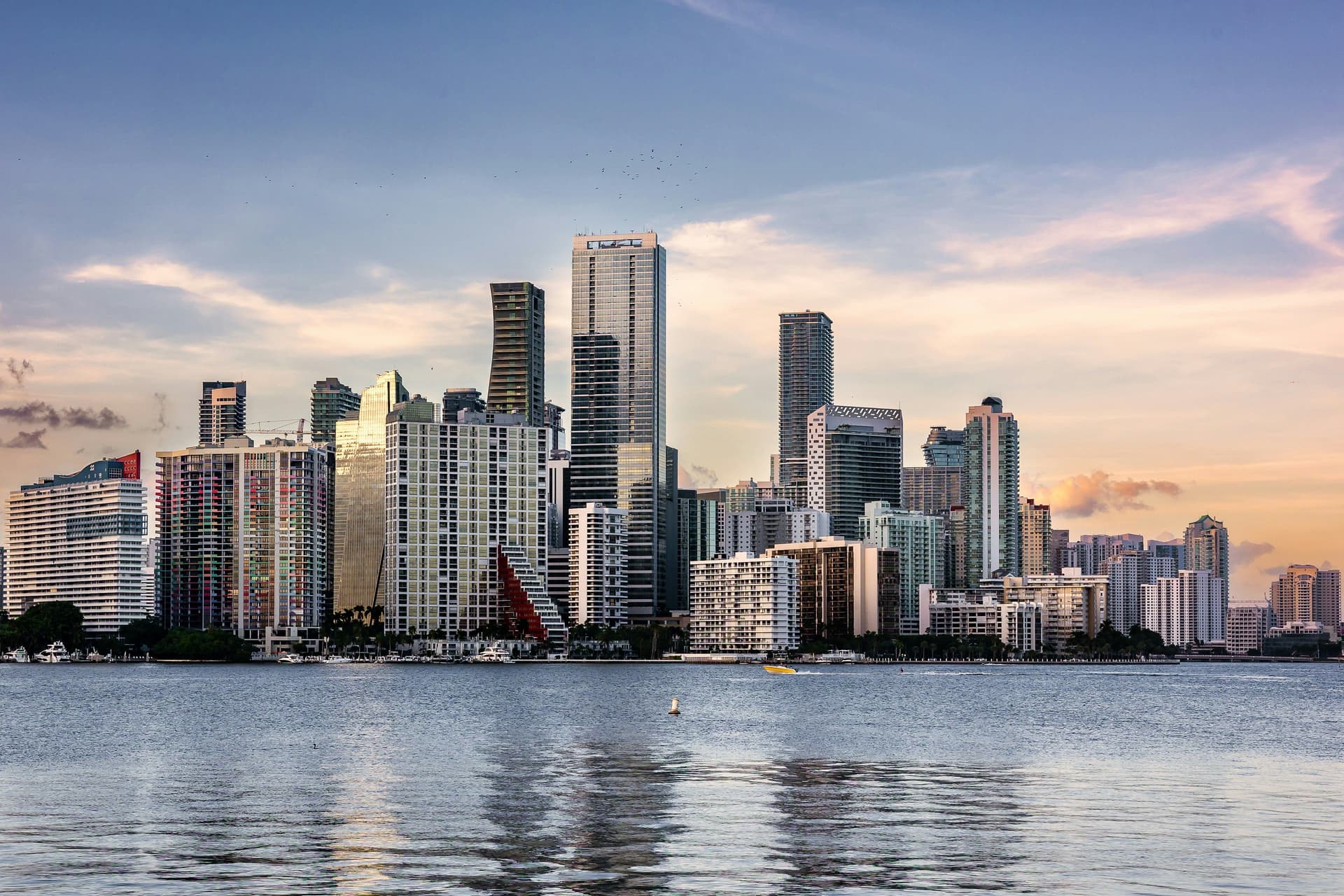Miami Condo Investment Calculator: ROI Analysis for 2025
You've been looking at Miami condos as investments, running numbers in your head while scrolling through listings. A $400,000 unit renting for $3,200 monthly looks attractive until you factor in HOA fees, property taxes, and the reality that your tenant might disappear every summer when the lease expires.
Miami real estate investment calculator tools can give you ballpark figures, but understanding condo ROI Miami requires digging into the specifics of seasonal rental markets, hurricane insurance, and neighborhoods where rental demand actually supports the numbers you're seeing online.
This analysis breaks down how to calculate realistic returns on Miami condo investments, from the upfront costs everyone forgets to factor in, to the neighborhood-by-neighborhood rental yield Miami data that determines whether your investment makes money or just looks good on paper.
For context on current market conditions, review our complete guide to buying condos in Miami. If you're considering luxury properties, our luxury Miami condos guide covers the unique investment considerations for high-end properties.
Understanding Real Estate ROI in Miami
Miami real estate investment returns come from three sources: rental income, property appreciation, and tax benefits. Getting the calculation right means understanding how each component works in Miami's specific market conditions.
Key Metrics: Cap Rates, Cash Flow, Appreciation
Capitalization Rate (Cap Rate): Cap rate measures annual net operating income as a percentage of purchase price. Miami condo cap rates typically range from 4-8%, depending on location and property type.
Cash Flow: Monthly rental income minus all operating expenses. Positive cash flow means the property pays for itself; negative cash flow means you're subsidizing the investment monthly.
Total Return: Combines cash flow, appreciation, and tax benefits for a complete return picture. Miami properties often show modest cash flow but strong total returns due to appreciation.
Rental yield Miami calculation:
- Gross rental yield = (Annual rental income ÷ Purchase price) × 100
- Net rental yield = (Annual rental income - Operating expenses) ÷ Purchase price × 100
Market Benchmarks for Miami Investments
Current Miami investment benchmarks (2025):
- Average gross rental yields: 6-9%
- Average net rental yields: 4-6%
- Historical appreciation: 4-7% annually
- Typical cash-on-cash returns: 5-10% for leveraged investments
Factors Affecting Investment Returns
Location factors:
- Proximity to employment centers and transportation
- Neighborhood safety and walkability
- Future development and infrastructure plans
- Tourist appeal and seasonal demand
Property-specific factors:
- Building age and condition
- HOA financial health and fee levels
- Rental restrictions and policies
- Parking availability and costs
Market timing factors:
- Interest rates affecting financing costs
- Supply and demand cycles
- Economic conditions in key buyer markets
- Regulatory changes affecting rentals
Understanding these factors helps you identify properties likely to outperform market averages versus those that might underperform despite attractive initial numbers.
Calculating Your Miami Condo Investment Returns
Accurate ROI calculation requires accounting for all costs and income, not just the obvious ones. Miami has some unique expenses that can surprise new investors.
Purchase Price and Associated Costs
Upfront investment costs:
Purchase price: $450,000 (example property)
Closing costs (typically 2-3% of purchase price):
- Title insurance: $1,800
- Attorney fees: $1,500
- Inspection and appraisal: $1,200
- Recording fees and taxes: $800
- Total closing costs: $5,300
Immediate improvements and setup:
- Basic furnishing for rentals: $8,000-15,000
- Initial marketing and leasing: $1,000-2,000
- Security deposits and utility setup: $500-1,000
Total initial investment: $465,000-475,000
Rental Income Projections
Market rental analysis for sample property:
Long-term rental income:
- Market rent: $3,200/month
- Annual gross income: $38,400
- Vacancy allowance (8%): -$3,072
- Net rental income: $35,328
Seasonal rental potential:
- Peak season (Dec-Apr): $4,200/month × 5 months = $21,000
- Off-season (May-Nov): $2,800/month × 7 months = $19,600
- Annual gross income: $40,600
- Vacancy allowance (12%): -$4,872
- Net seasonal rental income: $35,728
Short-term rental (Airbnb) potential:
- Average daily rate: $185
- Occupancy rate: 65%
- Annual gross income: $43,831
- Vacancy and marketing costs (20%): -$8,766
- Net short-term rental income: $35,065
Note that short-term rentals require more active management and may face regulatory restrictions in some buildings.
Operating Expenses and Management Fees
Annual operating expenses:
Fixed costs:
- HOA fees: $650/month × 12 = $7,800
- Property taxes: $4,500 (1% of assessed value)
- Insurance: $2,400 (including hurricane coverage)
- Total fixed costs: $14,700
Variable costs:
- Property management: 8-12% of gross rental income = $2,800-4,600
- Maintenance and repairs: $1,500-3,000 annually
- Marketing and leasing: $500-1,500 annually
- Utilities (if included): $1,200-2,400 annually
Total annual operating expenses: $20,500-26,200
Tax Benefits and Depreciation
Tax deduction benefits:
- Mortgage interest deduction
- Property tax deduction
- Operating expense deductions
- Depreciation deduction (residential property over 27.5 years)
Sample depreciation calculation:
- Property value (excluding land): $360,000
- Annual depreciation: $360,000 ÷ 27.5 = $13,091
Net operating income calculation:
- Gross rental income: $35,328
- Operating expenses: -$23,350
- Net operating income: $11,978
- Cash-on-cash return: 2.6% (on $465,000 investment)
Total return including appreciation:
- Cash flow: $11,978
- Estimated appreciation (5%): $22,500
- Tax benefits (estimated): $5,000
- Total annual return: $39,478 (8.5%)
Miami Neighborhoods: Investment Performance Comparison
Different Miami neighborhoods offer varying combinations of rental yields, appreciation potential, and management requirements. Here's how the major investment areas compare.
Brickell: High Rental Demand Analysis
Brickell attracts young professionals and corporate relocations, creating consistent rental demand but also facing significant new supply.
Brickell investment metrics:
- Average rental yields: 6-8%
- Typical cap rates: 5-6.5%
- Historical appreciation: 6.2% annually
- Vacancy rates: 5-8%
Brickell advantages:
- Strong job market and employment growth
- Public transportation access
- High rental demand from corporate relocations
- Walkable urban lifestyle appeals to young professionals
Brickell challenges:
- High competition from new construction
- Rising HOA fees in luxury buildings
- Traffic congestion affecting livability
- Market saturation in some price ranges
Investment strategy for Brickell: Focus on buildings 3-5 years old that have proven rental history but haven't yet faced major capital improvements. Avoid ground-floor units due to noise and security concerns.
Miami Beach: Tourism Impact on Returns
Miami Beach offers the highest rental rates but also faces the most seasonal volatility and regulatory scrutiny.
Miami Beach investment metrics:
- Average rental yields: 5-7%
- Typical cap rates: 4-5.5%
- Historical appreciation: 5.8% annually
- Vacancy rates: 10-15% (higher seasonality)
Miami Beach advantages:
- Premium rental rates year-round
- Strong international tourism demand
- Limited supply due to geographic constraints
- Iconic location with global recognition
Miami Beach challenges:
- Hurricane risk and mandatory evacuation zones
- Strict short-term rental regulations
- High insurance and maintenance costs
- Tourist crowds affecting year-round livability
Investment strategy for Miami Beach: Target properties that can command premium long-term rents rather than depending on short-term rental income. Focus on buildings with strong hurricane resistance and comprehensive insurance coverage.
Downtown: Urban Renewal and Growth Potential
Downtown Miami is experiencing rapid transformation, offering potential upside but requiring careful property selection.
Downtown investment metrics:
- Average rental yields: 7-9%
- Typical cap rates: 6-7.5%
- Historical appreciation: 7.1% annually
- Vacancy rates: 6-10%
Downtown advantages:
- More affordable entry points than Brickell or Beach
- Ongoing infrastructure and cultural development
- Growing residential population
- Good public transportation connections
Downtown challenges:
- Some areas still developing safety and walkability
- Limited weekend and evening activity in business districts
- Uncertainty about development timeline and success
- Higher tenant turnover in transitional areas
Investment strategy for Downtown: Focus on areas near cultural attractions and transportation hubs. Avoid properties dependent on future development that may not materialize on schedule.
Coconut Grove: Family Market Stability
The Grove appeals to families and long-term residents, offering stability but lower rental yields than urban areas.
Coconut Grove investment metrics:
- Average rental yields: 5-7%
- Typical cap rates: 4.5-6%
- Historical appreciation: 4.9% annually
- Vacancy rates: 4-7%
Grove advantages:
- Stable family rental market
- Lower tenant turnover
- Established neighborhood character
- Good schools attracting family tenants
Grove challenges:
- Limited rental rate growth potential
- Requires car for most transportation
- Less appeal to young professional market
- Competition from single-family home rentals
Investment strategy for Coconut Grove: Target properties suitable for families, with good school access and parking. Focus on long-term rental stability rather than maximum rental yields.
Seasonal Rental vs. Long-Term Rental Analysis
Miami's seasonal rental market creates opportunities and challenges that don't exist in most other cities. Understanding the trade-offs helps optimize your rental strategy.
Short-Term Rental (Airbnb) Potential
Short-term rental advantages:
- Premium daily rates during peak season
- Flexibility to use property personally
- Ability to adjust pricing based on demand
- Potential for higher overall returns
Short-term rental challenges:
- Higher management requirements and costs
- Regulatory restrictions in many buildings
- Income volatility and seasonal gaps
- Increased wear and tear on property
Financial comparison example:
- Long-term rental: $3,200/month × 11 months = $35,200 (assuming 1 month vacancy)
- Short-term rental: $185/night × 237 occupied nights = $43,845
- Management costs: Short-term requires 20-25% vs 8-12% for long-term
- Net income difference: Often minimal after higher management costs
Long-Term Rental Stability
Long-term rental advantages:
- Predictable monthly income
- Lower management requirements
- Less regulatory risk
- Reduced property wear and tear
Long-term rental considerations:
- Limited ability to adjust rents during lease terms
- Tenant screening becomes critical for asset protection
- Seasonal market may offer higher potential returns
- Less personal use flexibility
Management Requirements Comparison
Short-term rental management:
- Daily communication with guests
- Regular cleaning and maintenance
- Marketing and pricing optimization
- 24/7 availability for guest issues
Long-term rental management:
- Monthly rent collection
- Annual lease renewals
- Periodic property inspections
- Tenant screening and selection
Most investors find long-term rentals more suitable unless they plan to actively manage the property or hire specialized short-term rental management companies.
Market Timing and Investment Strategy
Miami real estate moves in cycles, and timing your investment can significantly impact returns. Understanding these patterns helps optimize entry and exit strategies.
Best Times to Buy in Miami Market Cycles
Seasonal timing:
- Best buying season: May-September when snowbirds return north
- Increased inventory: Summer months see more listings
- Motivated sellers: Off-season sellers often more flexible on pricing
- Lower competition: Fewer buyers during hot summer months
Economic cycle timing:
- Early recovery phases: Best time for long-term appreciation
- Market peaks: Focus on cash flow properties with immediate returns
- Market corrections: Opportunities for below-market purchases
- Interest rate cycles: Low rates improve cash flow for leveraged investments
Interest Rate Impact on Investment Returns
Interest rate effects on cash flow:
- 1% rate increase = ~$200-300 monthly payment increase on $400,000 mortgage
- Higher rates reduce buyer competition, potentially lowering purchase prices
- Fixed-rate mortgages protect against future rate increases
- Cash buyers gain advantage during high-rate periods
Economic Indicators to Watch
Local Miami indicators:
- Population growth and migration patterns
- Employment growth in key industries
- New construction permits and absorption rates
- Tourism visitor statistics and hotel occupancy
Broader economic indicators:
- Federal Reserve interest rate policies
- US dollar strength affecting international buyers
- Economic conditions in key buyer source countries (Canada, South America)
- Stock market performance affecting high-net-worth buyer activity
Investment timing strategies:
- Dollar-cost averaging through multiple small investments
- Contrarian investing during market pessimism
- Momentum investing during strong appreciation phases
- Seasonal timing for purchase and sale decisions
Risk Assessment for Miami Condo Investments
Every investment carries risks, but Miami real estate has some unique considerations that can significantly impact returns.
Market Volatility Factors
Demand-side volatility:
- International buyer sentiment and currency fluctuations
- US immigration and foreign investment policy changes
- Economic conditions in key buyer source countries
- Interest rate impacts on buyer financing ability
Supply-side volatility:
- New construction cycles creating temporary oversupply
- Condo conversion projects adding rental inventory
- Regulatory changes affecting rental property operations
- Infrastructure development affecting neighborhood desirability
Mitigation strategies:
- Diversify across neighborhoods and property types
- Focus on properties with multiple buyer/tenant appeal
- Maintain adequate cash reserves for market downturns
- Consider shorter-term investments during uncertain periods
Natural Disaster Considerations
Hurricane and flood risks:
- Mandatory evacuation zones affecting some Miami Beach properties
- Rising insurance costs for coastal properties
- Potential for significant damage and business interruption
- Impact on rental demand during active hurricane seasons
Risk mitigation:
- Comprehensive hurricane and flood insurance coverage
- Emergency preparedness plans for property protection
- Diversification outside high-risk coastal areas
- Reserve funds for potential damage and repair costs
Regulatory Risks and Changes
Rental regulation risks:
- Short-term rental restrictions and licensing requirements
- Rent control or tenant protection legislation
- Building code changes affecting older properties
- HOA rule changes restricting rental activities
Tax and legal risks:
- Property tax assessment increases
- Changes in depreciation or tax benefit rules
- Foreign investment restrictions or reporting requirements
- Local government revenue needs affecting property taxes
Risk management approach:
- Stay informed about proposed regulatory changes
- Build relationships with local property management professionals
- Maintain flexibility in rental strategies
- Consider professional property management to ensure compliance
Property investment returns in Miami can be attractive, but success requires realistic financial analysis, appropriate risk management, and understanding of local market dynamics that don't exist in other real estate markets.
Ready to analyze specific Miami condo investment opportunities? Visit Pink Miami to work with investment specialists who can help you evaluate properties based on accurate market data and realistic return projections.







